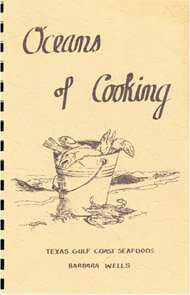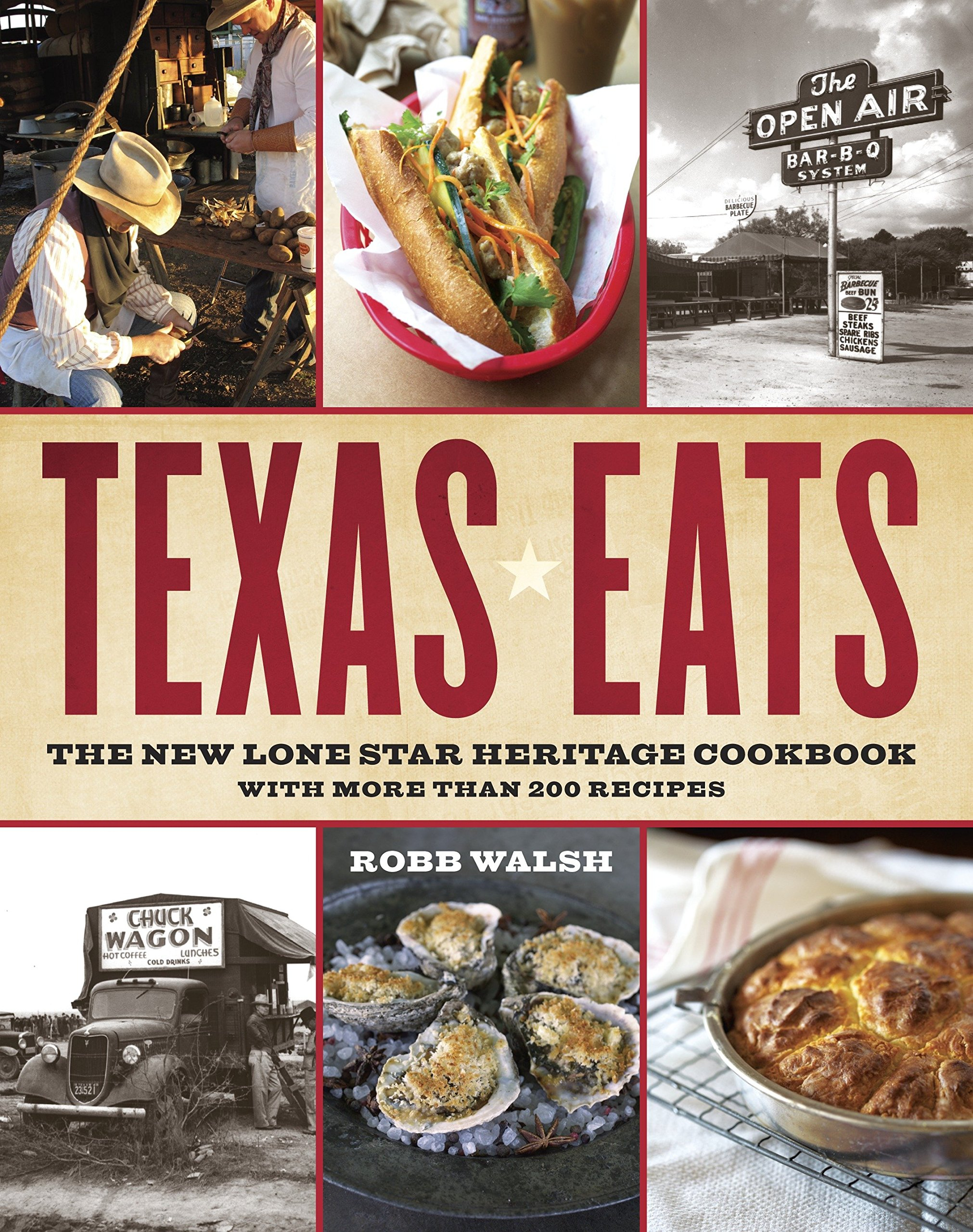Texas Eats: The New Lone Star Heritage Cookbook, with More Than 200 Recipes
Editorial Reviews
Review
“A rich, comprehensive portrait of Lone Star food that goes leagues beyond brisket and chicken-fried steak.”
—New York Times Book Review Texas Eats isn’t just a cookbook. Or a history book. It’s really the world of Texas food according to Walsh.
—Dallas Morning News “This book is rich with gravitas and gravy. But its true strength is the broad cast of previously unheralded characters—from Vietnamese pho masters in Houston to chicken-fried steak pioneers in Paradise—whose family histories and recipes tell us what it means to claim a Texas kitchen as your own.”
—John T Edge, series editor, Cornbread Nation: The Best of Southern Food Writing
“With a brilliant eye for detail, master storyteller Robb Walsh delivers a remarkable portrait of Lone Star food. Recipe by recipe, he shows that Texas is its own country, with its own reasons and contradictions and, thankfully, one of the purest and most unique cuisines in the continental United States.”
—Molly O’Neill, author of One Big Table: A Portrait of American Cooking
“Robb Walsh is the Homer of Brisket, the great storyteller of Texas food. Spending half a day with him, eating breakfast tacos, chicken-fried steak, and Galveston oysters, is getting a history lesson, adventure tale, and potential heart stoppage all at once. Luckily, with this book, you can pace yourself.”
—Francis Lam, Features Editor, Gilt Taste
“Robb Walsh’s new book has ‘Eat Me!’ written all over it.”
—Kinky Friedman
From the Inside Flap
In Texas Eats, Walsh covers the standards, from chicken-fried steak to cheese enchiladas to barbecued brisket. He also makes stops in East Texas, for some good old-fashioned soul food; the Hill Country, for German- and Czech-influenced favorites; the Panhandle, for traditional cowboy cooking; and the Gulf Coast, for timeless seafood dishes and lost classics like pickled shrimp. Texas Eats even covers recent trends, like Viet-Texan fusion and Pakistani fajitas. And yes, there are recipes for those beloved-but-obscure gems: King Ranch casserole, parisa, and barbecued crabs. With more than 200 recipes and stunning food photography, Texas Eats brings the richness of Texas food history vibrantly to life and serves up a hearty helping of real Texas flavor.
About the Author
Three time James Beard Award-winner Robb Walsh is the author of five previous Texas cookbooks, which combined have sold more than 300,000 copies. A former restaurant reviewer for the Houston Press and Austin Chronicle, Walsh currently co-owns El Real Tex-Mex Cafe in Houston with partners Bryan Caswell and Bill Floyd. Walsh is a co-founder and board member of Foodways Texas.
Excerpt. © Reprinted by permission. All rights reserved.
Chapter 1
Tartar Sauce and Hurricanes
When I checked into the Lighthouse Inn in Fulton, I noticed some old black-and-white photos of elegant resort hotels hanging on the walls. The front-desk clerk told me those hotels were once nearby, but they no longer existed. I didn’t have to ask why.
Many gorgeous spa hotels and upscale fishing lodges have been built along the Texas coast. Beachfront amusement parks that rivaled Coney Island once graced the sandy beaches, too. Most have been leveled by hurricanes.
But this was the first week of March, and the tropical storm season was months away. The Texas beachfront town of Rockport, with its charming crescent beach, and the neighboring fishing village of Fulton were putting on the annual celebration called Oysterfest. The event, which is a fund-raiser for the Fulton fire department, features the irresistible combination of cheap oysters on the half shell, draft beer, and live music.
Not many Texans realize that their home state is a leading oyster producer, ranking third behind Louisiana and Washington in total harvest most years. Texas is also a huge producer of crab and shrimp. But when you think of Texas you think of cattle, not mollusks or crustaceans. Is that because our cowboy image overshadows our prowess as fishermen? Or is it because most of our seafood is exported?
After eating my fill of fat, juicy, eight-dollar-a-dozen oysters at the enormous festival tent, I walked back along Fulton’s picture-book waterfront, with its handsome shrimp fleet and a marina with a huge bait shack at one end. The oyster lugs were tied up at their slips, with piles of oyster shells alongside them. I also passed another dock filled with expensive yachts and deep-sea fishing boats.
Named for a rock ledge along the waterfront, Rockport was once an important shipping center. In the late 1800s, the area was a major cattle-processing site and home to an international shipping industry. Those businesses were completely destroyed during the hurricanes of 1916 and 1919, and the port and cattle plants were never rebuilt.
The recorded history of the Texas coast is a litany of tropical storms, beginning with the one that washed the first European observer of Texas foodways, Cabeza de Vaca, up on the beach near Galveston Island in 1528. The expedition to Florida that he was a part of had met with several tropical storms. Cabeza de Vaca and his three surviving comrades, two other Spanish explorers and a North African servant named Esteban, spent two years with the Native Americans of Texas. On his return to Spain, Cabeza de Vaca published an account that provides the earliest insight into the indigenous diet. According to his book, the Karankawa tribe with whom he lived moved around South Texas following seasonal food sources.
In winter, from January to April, the coastal people lived almost entirely on oysters that they harvested from the Laguna Madre, the series of brackish bays that lie between the mainland and the barrier islands that hug the coast of Texas. When the wild dewberries ripened in May, the Karankawa moved inland to feast on them. In the summer, they migrated to an area south of what is now San Antonio, where they harvested prickly pears. When fall arrived, the tribe headed for the banks of what they called the “river of nuts” (probably the Guadalupe), where they ate pecans that fell from the trees. In the late fall and early winter, they harvested cattails and roots such as arrowroot along the coast and fished from their canoes and with fish weirs. And when the weather turned cold, the Karankawa went back to the oyster beds.
Archeological research indicates that the heaviest population concentrations of early aboriginal peoples occurred along the Texas coast at points where freshwater sources entered the Laguna Madre. These are the areas of brackish water where oyster reefs formed and where several marine species came to spawn. You would expect these areas to be heavily populated today. They aren’t.
When you look at a map of the United States, you notice that all of the biggest cities of the East Coast and the West Coast are located on the water. But not in Texas. Houston, the biggest city in the state and the largest port on the Caribbean basin, is connected to the Gulf of Mexico by a long ship channel.
It’s not that Texans didn’t try to build their cities on the water. They did. The city of Galveston, eighty miles south of Houston, was once the biggest city in the state. It was built on Galveston Island, the barrier island directly facing the Gulf. The hurricane that hit Galveston without warning in 1900 covered the island with a storm surge that reached the upper floors of downtown office buildings. More than three thousand people died. The city never completely recovered. But at least Galveston still survives.
In its day, Indianola, the other major Texas port city of the 1800s, was said to be the best deepwater harbor on the Gulf and the port of call for the biggest steamships. As the arrival city for many European immigrants, it might have become a major city. But Indianola was leveled by a hurricane in September 1875. The town wasn’t even completely rebuilt when it was hit again by another hurricane in 1886. Today, Indianola is a ghost town.
Much of the Texas coast is hauntingly beautiful. But longtime residents are prone to melancholy. They talk about the ruins of former homes and businesses lost to hurricanes the way war veterans talk about their battle scars. And every Texas beach resort and seafood restaurant seems to be built on the ruins of something more ambitious that no longer exists.
Consider, for instance, the sad case of Loyola Beach. The saga began three-quarters of a century ago, with Orlando Underbrink’s dreams of grandeur. In 1935, Underbrink, a farmer who worked land not far from Baffin Bay, bought up the waterfront property and built a boardwalk, a fishing pier, rental cottages, and a restaurant he called Orlando’s Café. He named the seaside resort Loyola Beach, and it got off to a good start, with lots of vacationers and fishermen taking advantage of its facilities. The town of Riviera built nearby was to be the gateway to the Texas version of a coastal paradise. But the would-be resort area was slammed by a pair of hurricanes—and then came World War II.
The clapboard café was the only business that survived the storms and the war. It was run by a French war bride, Blanche “Mom” Wright. She hired a cook named Cottle Ware, who had previously worked all over the state, including in the cafeteria at Texas A&M. When Mom Wright died in 1945, Cottle Ware and his wife, Alta Faye, inherited the business and renamed it the King’s Inn. The name was no doubt inspired by the nearby town of Kingsville, headquarters of the historic King Ranch. The Wares made the restaurant a legend and ran it until their deaths. Their son Randy Ware took over in 1978. He changed the name over the entrance to The Famous King’s Inn.
Like legions of fellow Texans, I count the King’s Inn as one of my favorite restaurants. Perched on a lonely bluff overlooking Baffin Bay, miles from any major population center, the place sucked me in with its eccentric air of romantic tragedy. There is a quirkiness about it that gets under your skin. The King’s Inn looks like a decrepit wooden beach house. The interior décor is appalling. The carpets are industrial gray and the acoustic ceiling tiles are stained and ill fitting. The trim near the bathroom is painted about as far as you can reach, and then the paint job ends.
It could be an incredibly depressing atmosphere, if it wasn’t for the hordes of enthusiastic seafood eaters who always crowd the place. The last time I visited, my wife and I were seated next to a huge Christmas party. The participants were members of the train engineer’s union, and it seems that the Brotherhood of Locomotive Engineers and their significant others know how to party. More than a hundred people were sitting at the long tables, drinking pitchers of beer, laughing loudly, and eating platter after platter of shrimp. One of the organizers stopped by our table to shoot the breeze. I felt like we were part of the festivities.
I ordered oysters on the half shell and a Bombay salad to start, but the waiter dropped a bombshell. He said that owner Randy Ware had decided not to serve raw oysters anymore.
When I got home, I called Randy Ware to ask why. He said that the King’s Inn hasn’t stopped serving oysters, he just hasn’t been able to find any good ones since Hurricane Ike stirred things up in Galveston Bay, home to the state’s biggest oyster reefs. When he finds some quality oysters to serve, he told me, he will start selling them again.
The paradox of Texas seafood is that the hurricanes that destroy the beach resorts, mess up the oyster reefs, and put our favorite seafood restaurants out of business are also the reason the Gulf Coast of Texas has such a bounty of seafood. Chesapeake Bay and New York Harbor were once blessed with enormous stocks of oysters and fish, but the seafood there is mostly gone. The Eastern Seaboard proved to be a perfect place to build mills, factories, and mighty cities. And so the wetlands were paved over and the waterways were polluted.
The Gulf of Mexico may go the same way soon. Oil spills like the BP Deepwater Horizon disaster disrupted some of the Louisiana oyster beds, shrimp-breeding areas, and fishing grounds. How long the marine ecosystem will be able to keep recovering from such devastating pollution events remains to be seen. But for now, the Gulf of Mexico is the most productive fishery in the United States and the home of the nation’s last significant wild oyster reefs.
The settlers of Texas tried to build coastal towns and cities like the ones on the East and West Coasts, with disastrous results. Due to the frequent hurricanes, much of the coastline of Texas and Louisiana remains undeveloped, which is why such a large a percentage of the nation’s remaining wetlands are found there. And the wetlands are a necessary part of the ecosystem that sustains the oysters, shrimp, and fish along the Gulf Coast.
It’s easy to fall in love with the Texas coast and its desolate beaches, melancholy history, and succulent seafood. But think twice before you decide to build a resort there. I asked Randy Ware if he had any plans for the future of the King’s Inn. “Yeah, I’m going to try and keep it open,” he replied.
Griddled Whole Fish
Red snapper is excellent cooked whole; so are sea bream, sheephead, and lots of other Gulf fish (see Trash Fish, page 27). Cooking the fish on the griddle is much easier if the fish is covered with a lid as it cooks. Putting a couple of ice cubes under the lid now and then adds some welcome steam.
Serves 4
1 whole fish, about 3 pounds, cleaned
½ cup olive oil
1 yellow onion, minced
3 tablespoons freshly squeezed lemon juice
2 tablespoons seafood seasoning (page 9)
Ice cubes
Lemon slices, for garnish
Pope’s Tartar Sauce (page 7), for serving
Rinse the fish and cut off the gill fins. Using a sharp knife, make 3 vertical slashes about 1½ inches apart on both sides of the fish, cutting all the way to the bone.
In a baking dish, stir together the oil, onion, lemon juice, and seasoning mix. Put the fish in the baking dish and bend it so that the slashes on one side spread open. Spoon the marinade into the slashes. Flip the fish and repeat on the other side.
Preheat a griddle to medium and spray with nonstick cooking spray. Remove the fish from the baking dish and put it on the hot griddle. Tuck a couple of ice cubes near the fish and cover the fish with a pot lid. Cook on one side for 7 minutes. Turn the fish over, add a couple more ice cubes, re-cover, and cook for 7 minutes on the second side. At this point, test the fish for doneness by slipping the tip of a sharp knife between the top fillet and the backbone. If it is still a little raw, transfer it to a roasting pan, place in a 350°F oven, and finish cooking for 5 to 10 minutes longer, or until the fish is done to taste.
Put the whole fish on a platter and garnish with the lemon slices. Carve the fish at the table. The flesh will fall away from the bone easily along the slash lines. Carefully remove any obvious pin bones. Serve with the tartar sauce.
Tartar Sauce and Hurricanes
When I checked into the Lighthouse Inn in Fulton, I noticed some old black-and-white photos of elegant resort hotels hanging on the walls. The front-desk clerk told me those hotels were once nearby, but they no longer existed. I didn’t have to ask why.
Many gorgeous spa hotels and upscale fishing lodges have been built along the Texas coast. Beachfront amusement parks that rivaled Coney Island once graced the sandy beaches, too. Most have been leveled by hurricanes.
But this was the first week of March, and the tropical storm season was months away. The Texas beachfront town of Rockport, with its charming crescent beach, and the neighboring fishing village of Fulton were putting on the annual celebration called Oysterfest. The event, which is a fund-raiser for the Fulton fire department, features the irresistible combination of cheap oysters on the half shell, draft beer, and live music.
Not many Texans realize that their home state is a leading oyster producer, ranking third behind Louisiana and Washington in total harvest most years. Texas is also a huge producer of crab and shrimp. But when you think of Texas you think of cattle, not mollusks or crustaceans. Is that because our cowboy image overshadows our prowess as fishermen? Or is it because most of our seafood is exported?
After eating my fill of fat, juicy, eight-dollar-a-dozen oysters at the enormous festival tent, I walked back along Fulton’s picture-book waterfront, with its handsome shrimp fleet and a marina with a huge bait shack at one end. The oyster lugs were tied up at their slips, with piles of oyster shells alongside them. I also passed another dock filled with expensive yachts and deep-sea fishing boats.
Named for a rock ledge along the waterfront, Rockport was once an important shipping center. In the late 1800s, the area was a major cattle-processing site and home to an international shipping industry. Those businesses were completely destroyed during the hurricanes of 1916 and 1919, and the port and cattle plants were never rebuilt.
The recorded history of the Texas coast is a litany of tropical storms, beginning with the one that washed the first European observer of Texas foodways, Cabeza de Vaca, up on the beach near Galveston Island in 1528. The expedition to Florida that he was a part of had met with several tropical storms. Cabeza de Vaca and his three surviving comrades, two other Spanish explorers and a North African servant named Esteban, spent two years with the Native Americans of Texas. On his return to Spain, Cabeza de Vaca published an account that provides the earliest insight into the indigenous diet. According to his book, the Karankawa tribe with whom he lived moved around South Texas following seasonal food sources.
In winter, from January to April, the coastal people lived almost entirely on oysters that they harvested from the Laguna Madre, the series of brackish bays that lie between the mainland and the barrier islands that hug the coast of Texas. When the wild dewberries ripened in May, the Karankawa moved inland to feast on them. In the summer, they migrated to an area south of what is now San Antonio, where they harvested prickly pears. When fall arrived, the tribe headed for the banks of what they called the “river of nuts” (probably the Guadalupe), where they ate pecans that fell from the trees. In the late fall and early winter, they harvested cattails and roots such as arrowroot along the coast and fished from their canoes and with fish weirs. And when the weather turned cold, the Karankawa went back to the oyster beds.
Archeological research indicates that the heaviest population concentrations of early aboriginal peoples occurred along the Texas coast at points where freshwater sources entered the Laguna Madre. These are the areas of brackish water where oyster reefs formed and where several marine species came to spawn. You would expect these areas to be heavily populated today. They aren’t.
When you look at a map of the United States, you notice that all of the biggest cities of the East Coast and the West Coast are located on the water. But not in Texas. Houston, the biggest city in the state and the largest port on the Caribbean basin, is connected to the Gulf of Mexico by a long ship channel.
It’s not that Texans didn’t try to build their cities on the water. They did. The city of Galveston, eighty miles south of Houston, was once the biggest city in the state. It was built on Galveston Island, the barrier island directly facing the Gulf. The hurricane that hit Galveston without warning in 1900 covered the island with a storm surge that reached the upper floors of downtown office buildings. More than three thousand people died. The city never completely recovered. But at least Galveston still survives.
In its day, Indianola, the other major Texas port city of the 1800s, was said to be the best deepwater harbor on the Gulf and the port of call for the biggest steamships. As the arrival city for many European immigrants, it might have become a major city. But Indianola was leveled by a hurricane in September 1875. The town wasn’t even completely rebuilt when it was hit again by another hurricane in 1886. Today, Indianola is a ghost town.
Much of the Texas coast is hauntingly beautiful. But longtime residents are prone to melancholy. They talk about the ruins of former homes and businesses lost to hurricanes the way war veterans talk about their battle scars. And every Texas beach resort and seafood restaurant seems to be built on the ruins of something more ambitious that no longer exists.
Consider, for instance, the sad case of Loyola Beach. The saga began three-quarters of a century ago, with Orlando Underbrink’s dreams of grandeur. In 1935, Underbrink, a farmer who worked land not far from Baffin Bay, bought up the waterfront property and built a boardwalk, a fishing pier, rental cottages, and a restaurant he called Orlando’s Café. He named the seaside resort Loyola Beach, and it got off to a good start, with lots of vacationers and fishermen taking advantage of its facilities. The town of Riviera built nearby was to be the gateway to the Texas version of a coastal paradise. But the would-be resort area was slammed by a pair of hurricanes—and then came World War II.
The clapboard café was the only business that survived the storms and the war. It was run by a French war bride, Blanche “Mom” Wright. She hired a cook named Cottle Ware, who had previously worked all over the state, including in the cafeteria at Texas A&M. When Mom Wright died in 1945, Cottle Ware and his wife, Alta Faye, inherited the business and renamed it the King’s Inn. The name was no doubt inspired by the nearby town of Kingsville, headquarters of the historic King Ranch. The Wares made the restaurant a legend and ran it until their deaths. Their son Randy Ware took over in 1978. He changed the name over the entrance to The Famous King’s Inn.
Like legions of fellow Texans, I count the King’s Inn as one of my favorite restaurants. Perched on a lonely bluff overlooking Baffin Bay, miles from any major population center, the place sucked me in with its eccentric air of romantic tragedy. There is a quirkiness about it that gets under your skin. The King’s Inn looks like a decrepit wooden beach house. The interior décor is appalling. The carpets are industrial gray and the acoustic ceiling tiles are stained and ill fitting. The trim near the bathroom is painted about as far as you can reach, and then the paint job ends.
It could be an incredibly depressing atmosphere, if it wasn’t for the hordes of enthusiastic seafood eaters who always crowd the place. The last time I visited, my wife and I were seated next to a huge Christmas party. The participants were members of the train engineer’s union, and it seems that the Brotherhood of Locomotive Engineers and their significant others know how to party. More than a hundred people were sitting at the long tables, drinking pitchers of beer, laughing loudly, and eating platter after platter of shrimp. One of the organizers stopped by our table to shoot the breeze. I felt like we were part of the festivities.
I ordered oysters on the half shell and a Bombay salad to start, but the waiter dropped a bombshell. He said that owner Randy Ware had decided not to serve raw oysters anymore.
When I got home, I called Randy Ware to ask why. He said that the King’s Inn hasn’t stopped serving oysters, he just hasn’t been able to find any good ones since Hurricane Ike stirred things up in Galveston Bay, home to the state’s biggest oyster reefs. When he finds some quality oysters to serve, he told me, he will start selling them again.
The paradox of Texas seafood is that the hurricanes that destroy the beach resorts, mess up the oyster reefs, and put our favorite seafood restaurants out of business are also the reason the Gulf Coast of Texas has such a bounty of seafood. Chesapeake Bay and New York Harbor were once blessed with enormous stocks of oysters and fish, but the seafood there is mostly gone. The Eastern Seaboard proved to be a perfect place to build mills, factories, and mighty cities. And so the wetlands were paved over and the waterways were polluted.
The Gulf of Mexico may go the same way soon. Oil spills like the BP Deepwater Horizon disaster disrupted some of the Louisiana oyster beds, shrimp-breeding areas, and fishing grounds. How long the marine ecosystem will be able to keep recovering from such devastating pollution events remains to be seen. But for now, the Gulf of Mexico is the most productive fishery in the United States and the home of the nation’s last significant wild oyster reefs.
The settlers of Texas tried to build coastal towns and cities like the ones on the East and West Coasts, with disastrous results. Due to the frequent hurricanes, much of the coastline of Texas and Louisiana remains undeveloped, which is why such a large a percentage of the nation’s remaining wetlands are found there. And the wetlands are a necessary part of the ecosystem that sustains the oysters, shrimp, and fish along the Gulf Coast.
It’s easy to fall in love with the Texas coast and its desolate beaches, melancholy history, and succulent seafood. But think twice before you decide to build a resort there. I asked Randy Ware if he had any plans for the future of the King’s Inn. “Yeah, I’m going to try and keep it open,” he replied.
Griddled Whole Fish
Red snapper is excellent cooked whole; so are sea bream, sheephead, and lots of other Gulf fish (see Trash Fish, page 27). Cooking the fish on the griddle is much easier if the fish is covered with a lid as it cooks. Putting a couple of ice cubes under the lid now and then adds some welcome steam.
Serves 4
1 whole fish, about 3 pounds, cleaned
½ cup olive oil
1 yellow onion, minced
3 tablespoons freshly squeezed lemon juice
2 tablespoons seafood seasoning (page 9)
Ice cubes
Lemon slices, for garnish
Pope’s Tartar Sauce (page 7), for serving
Rinse the fish and cut off the gill fins. Using a sharp knife, make 3 vertical slashes about 1½ inches apart on both sides of the fish, cutting all the way to the bone.
In a baking dish, stir together the oil, onion, lemon juice, and seasoning mix. Put the fish in the baking dish and bend it so that the slashes on one side spread open. Spoon the marinade into the slashes. Flip the fish and repeat on the other side.
Preheat a griddle to medium and spray with nonstick cooking spray. Remove the fish from the baking dish and put it on the hot griddle. Tuck a couple of ice cubes near the fish and cover the fish with a pot lid. Cook on one side for 7 minutes. Turn the fish over, add a couple more ice cubes, re-cover, and cook for 7 minutes on the second side. At this point, test the fish for doneness by slipping the tip of a sharp knife between the top fillet and the backbone. If it is still a little raw, transfer it to a roasting pan, place in a 350°F oven, and finish cooking for 5 to 10 minutes longer, or until the fish is done to taste.
Put the whole fish on a platter and garnish with the lemon slices. Carve the fish at the table. The flesh will fall away from the bone easily along the slash lines. Carefully remove any obvious pin bones. Serve with the tartar sauce.
SKU: 076792150X
Category: Culinary
Related products
-

The Big Texas Cookbook: Food That Defines the Lone Star State
$17.99 -

Legends of Texas Barbecue Cookbook: Recipes and Recollections from the Pitmasters, Revised & Updated with 32 New Recipes!
$51.10 -

Mushrooms of Texas Identification Record Book: A Simple Take Along Book to Identify and Track Mushrooms in the South
$8.99 -

Oceans of Cooking: Texas Gulf Coast Seafoods
$0.00

